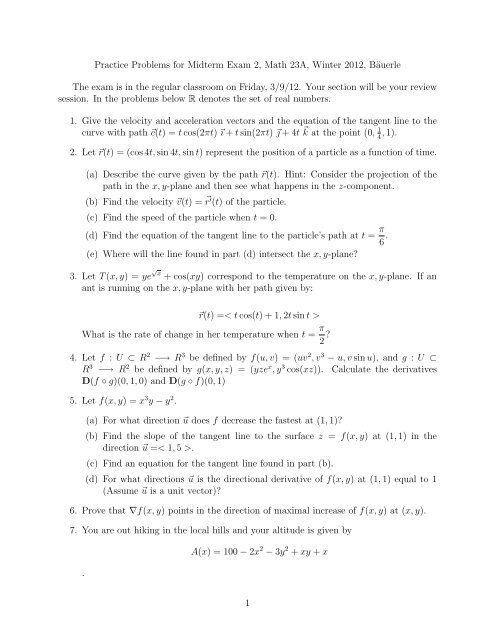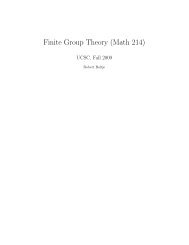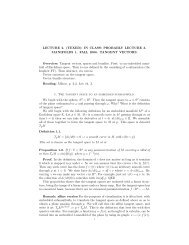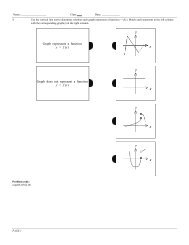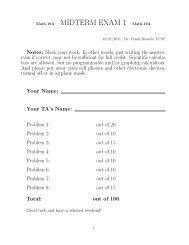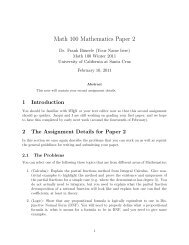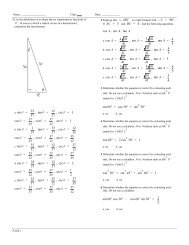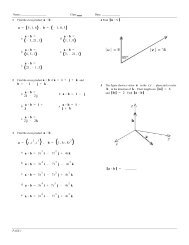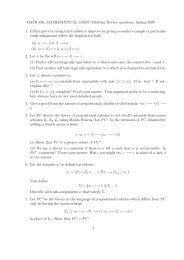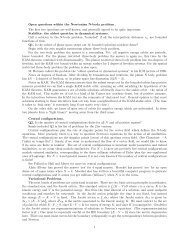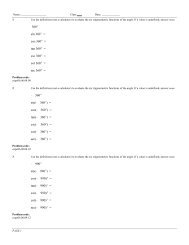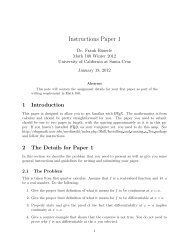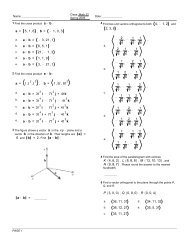Practice Problems for Midterm Exam 2, Math 23A, Winter 2012 ...
Practice Problems for Midterm Exam 2, Math 23A, Winter 2012 ...
Practice Problems for Midterm Exam 2, Math 23A, Winter 2012 ...
Create successful ePaper yourself
Turn your PDF publications into a flip-book with our unique Google optimized e-Paper software.
<strong>Practice</strong> <strong>Problems</strong> <strong>for</strong> <strong>Midterm</strong> <strong>Exam</strong> 2, <strong>Math</strong> <strong>23A</strong>, <strong>Winter</strong> <strong>2012</strong>, BäuerleThe exam is in the regular classroom on Friday, 3/9/12. Your section will be your reviewsession. In the problems below R denotes the set of real numbers.1. Give the velocity and acceleration vectors and the equation of the tangent line to thecurve with path ⃗c(t) =t cos(2πt) ⃗ı + t sin(2πt) ⃗j +4t ⃗ k at the point (0, 1 4 , 1).2. Let ⃗r(t) = (cos 4t, sin 4t, sin t) represent the position of a particle as a function of time.(a) Describe the curve given by the path ⃗r(t). Hint: Consider the projection of thepath in the x, y-plane and then see what happens in the z-component.(b) Find the velocity ⃗v(t) =⃗r ′ (t) of the particle.(c) Find the speed of the particle when t = 0.(d) Find the equation of the tangent line to the particle’s path at t = π 6 .(e) Where will the line found in part (d) intersect the x, y-plane?3. Let T (x, y) =ye √x + cos(xy) correspond to the temperature on the x, y-plane. If anant is running on the x, y-plane with her path given by:⃗r(t) =What is the rate of change in her temperature when t = π 2 ?4. Let f : U ⊂ R 2 −→ R 3 be defined by f(u, v) =(uv 2 ,v 3 − u, v sin u), and g : U ⊂R 3 −→ R 2 be defined by g(x, y, z) = (yze x ,y 3 cos(xz)). Calculate the derivativesD(f ◦ g)(0, 1, 0) and D(g ◦ f)(0, 1)5. Let f(x, y) =x 3 y − y 2 .(a) For what direction ⃗u does f decrease the fastest at (1, 1)?(b) Find the slope of the tangent line to the surface z = f(x, y) at (1, 1) in thedirection ⃗u =< 1, 5 >.(c) Find an equation <strong>for</strong> the tangent line found in part (b).(d) For what directions ⃗u is the directional derivative of f(x, y) at (1, 1) equal to 1(Assume ⃗u is a unit vector)?6. Prove that ∇f(x, y) points in the direction of maximal increase of f(x, y) at (x, y).7. You are out hiking in the local hills and your altitude is given by.A(x) = 100 − 2x 2 − 3y 2 + xy + x1
(a) What are the (x, y)-coordinates of the highest point.(b) Find a vector ⃗u pointing from (2, 3) to the point found above.(c) What x, y direction should you set off in from (2, 3) to go up the fastest?(d) How do you reconcile your answers to the last two questions?8. Find and classify all critical points <strong>for</strong>f(x, y) =3xy − x 2 y − xy 29. Compute and explain what the following represent geometrically <strong>for</strong> the function fgiven by f(x, y) =x 2 + y 2 .∂f ∂f(1, 2),∂x ∂y (1, 2),D ⃗uf(1, 2), ∂2 f(∂x (1, 2), ∇f(1, 2), |∇f(1, 2)|, 2− ∂f∂x)(1, 2), −∂f∂y (1, 2), 1 .10. Find Df, the Hessian Hf and the second order Taylor <strong>for</strong>mula <strong>for</strong> f(x, y) = (x − y) 2at (0, 0) and g(x, y) = sin x at ( π y 2 , 1).11. Find the maximum and minimum value of the function f(x, y) =x 2 + y 2 − x − y +1in the disk D defined by x 2 + y 2 ≤ 2. Why do such extreme values exist?12. Captain Ralph is out <strong>for</strong> a flight again in his space ship, traveling at a constant speedof e 6 meters per second. The temperature of the ship’s hull when he is at location(x, y, z) is given byT (x, y, z) =e −x2 −y 2 −z 2where x, y and z are measured in meters. He is currently at (1, 2, 1). Describe the setof possible directions in which he may proceed to bring the ship’s hull temperaturedown at exactly a rate of 3 √ 2 degrees per second.13. Consider the surface given byx 3 y 2 z =1(a) Find the equation of the tangent plane to the surface at the point P = (1, 1, 1).(b) Explain why there is no point on this surface where the tangent plane is parallelto the x, y-plane.14. Find and classify all critical points <strong>for</strong> the functionG(x, y) = 1 4 x4 − 5 3 x3 + y 3 +3x 2 − 3 2 y2 + 202


